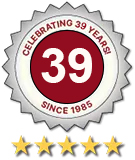Calculate the SCFM.
Temperature Sensors
Refractory / Noble Metal Thermocouples - Overview
High Temperature Thermocouple Probes
These Thermocouples have been designed for use in oxidizing, neutral and reducing environments. The materials used are of the highest quality, purities and manufacturing standards. Applications in all type of furnaces can be measured with these types of sensors. Temperature ranges to +4200°F are available. All standard refractory metal and noble metal thermocouple alloys are available. (C, F, G, R, S and B).
High Temperature Thermocouples are defined as sensors used at temperatures of 2000°F and beyond. These Sensors are generally made from refractory/noble metals and refractory ceramics.
Temperatures up to 5000°F can be obtained by using special design techniques and materials that have extended EMF tables. Applications can vary from extremely high-temperature furnaces to rocket engines and munitions.
For any applications regarding the above temperature sensors that are not profiled in the overall reference sections, please consult Convectronics’ Engineers for application, design or technical information on your current or future requirements at 1-800-633-0166 or [email protected]
Convectronics offers thermocouples utilizing noble metals, refractory metals, refractory ceramics and other exotic materials for the sheath, thermocouple wires and insulation. Our thermocouples are fabricated using the highest manufacturing standards available, which ensures maximum performance and life for these sensors.
Thermocouple Elements
| Calibration | Max. Oper. Temp. |
Max. Expos. Temp. |
Recommended Environment |
|---|---|---|---|
| Pt-10% Rh/Pt ANSI Type S |
2700°F 1482°C |
3100°F 1704°C |
Oxidizing, Inert |
| Pt-13% Rh/Pt ANSI Type R |
2700°F 1482°C |
1300°F 1704°C |
Oxidizing, Inert |
| Pt-30% Rh/Pt-6%Rh ANSI Type B |
3100°F 1704°C |
3220°F 1770°C |
Oxidizing, Inert |
| W/W-26% Re W-5% Re/W-26%Re W-3% Re/W-25%Re |
5000°F 2760°C |
5430°F 3000°C |
Vacuum, High Purity, Hydrogen & Inert. |
| Pt-Platinum, Rh-Rhodium, W-Tungsten, Re-Rhenium | |||
| Calibration | Max. Oper. Temp. |
Max. Expos. Temp. |
Recommended Environment |
|---|---|---|---|
| Pt-10% Rh/Pt ANSI Type S |
2700°F 1482°C |
3100°F 1704°C |
Oxidizing, Inert |
| Pt-13% Rh/Pt ANSI Type R |
2700°F 1482°C |
1300°F 1704°C |
Oxidizing, Inert |
| Pt-30% Rh/Pt-6%Rh ANSI Type B |
3100°F 1704°C |
3220°F 1770°C |
Oxidizing, Inert |
| W/W-26% Re W-5% Re/W-26%Re W-3% Re/W-25%Re |
5000°F 2760°C |
5430°F 3000°C |
Vacuum, High Purity, Hydrogen & Inert. |
| Pt-Platinum, Rh-Rhodium, W-Tungsten, Re-Rhenium | |||
Refractory Oxide Insulators
The resistivity of metal oxides decreases with increasing temperature. Above 3600°F only beryllia retains sufficient resistivity for most applications.
| Material | Approx. Melt. Temp. |
Max. Rec. Temp. | |
|---|---|---|---|
| Hard- Fired | Swaged | ||
| Magnesia Mg0 |
5070°F 2800°C |
N/A | 3400°F 1870°C |
| Alumina AL2O3 |
3650°F 2010°C |
3200°F 1760°C |
3000°F 1650°C |
| Beryllia* Be0 |
4620°F 2550°C |
4200°F 2315°C |
N/A |
| Hafnia HfO2 |
5252°F 2900°C |
4352°F 2400°C |
N/A |
| * Caution: Beryllia Dusts are toxic | |||
| Material | Approx. Melt. Temp. |
Max. Rec. Temp. | |
|---|---|---|---|
| Hard- Fired | Swaged | ||
| Magnesia Mg0 |
5070°F 2800°C |
N/A | 3400°F 1870°C |
| Alumina AL2O3 |
3650°F 2010°C |
3200°F 1760°C |
3000°F 1650°C |
| Beryllia* Be0 |
4620°F 2550°C |
4200°F 2315°C |
N/A |
| Hafnia HfO2 |
5252°F 2900°C |
4352°F 2400°C |
N/A |
| * Caution: Beryllia Dusts are toxic | |||
Applications
Oxidizing, reducing and inert gas furnaces, gas burners, ovens, nuclear power generating plants, exhaust gases, wind tunnels, pollution control and high temperature process control applications.
Specifications of Sheath Materials
TANTALUM (Ta):
Melting point of 5430°F. The most corrosive resistant of the refractory metals. Corrosion resistant to most chemicals up to 3000°F. Good in reducing or neutral atmospheres at elevated temperatures. Poor in oxidizing atmospheres. Excellent for thermal cycling applications.
MOLYBDENUM (Mo):
Excellent mechanical properties at elevated temperatures. Melting point at 4750°F. Excellent in reducing or neutral atmospheres. It has low thermal-neutron capture cross-section and excellent thermal shock resistance. Poor in oxidizing atmospheres. Excellent for thermal cycling applications.
ALUMINA (AL2O3):
This high purity sintered aluminum oxide (99.5% AL2O3, dense) has a melting point of 3686°F (2030°C) and an upper working service temperature of 3452°F (1900°C). It can be used in oxidizing, reducing or high vacuum applications. (Not recommended for use in high vacuum environments in the presence of graphite at temperatures exceeding 2372°F (1300°C)). AL2O3 has high thermal conductivity and therefore good resistance to thermal shock. It has excellent resistance to chemical attack. Poor for thermal cycling applications.
ZIRCONIA (ZRO2):
Zirconium oxide is fully stabilized with exceptional refractory properties, which include the highest melting point and lowest thermal conductivity of any refractory. It is not wet by most molten metals, is generally inert to oxidizing and reducing atmospheres, and resists most chemical reactions. Usable to 4400°F, it is impervious (0% water absorption). Poor for thermal cycling applications.
FUSED QUARTZ:
(Fused silica) consists of 99.9% SIO2. Most acids, metals, chlorine and bromine are unreactive with fused silica at ordinary temperatures. It is slightly attacked by alkaline solutions, the reaction rate increasing with temperature and concentration of thermal expansion, 0.55 x 10-6 cm/cm/°F (0-572°F). This is 1/34th that of copper, 1/17th of platinum and 1/9th of tungsten. This low expansion produces a high thermal shock resistance, it can be heated to 2700°F, and immersed into ice water without cracking. Good for oxidizing, inert or neutral atmospheres to 3050°F. Excellent for thermal shock applications. Divitrifies rapidly at temperatures above 1800°F causing microscopic surface cracking (hazy film) upon cooling.



